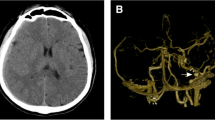Abstract
Evidence of areas of increased attenuation density within lateral ventricles at computed tomography (CT) of the brain is a finding of acute or subacute intraventricular hemorrhage. The purpose of this case report is to describe a 14-year-old female who presented with an episode of complicated migraine. Brain CT showed an area of high attenuation density (35 Hounsfield Units) in the trigone and occipital horn of the right lateral ventricle, mimicking a blood-fluid level from subacute intraventricular hemorrhage. Magnetic resonance imaging (MRI) of the brain showed that this resulted from gray matter lining a deep calcarine fissure. A deep calcarine fissure may mimic intraventricular hemorrhage at CT. Correct CT and MRI interpretation allows to avoid invasive diagnostic tests including lumbar puncture or intra-arterial catheter angiography.


Similar content being viewed by others
References
Given CA 2nd, Burdette JH, Elster AD et al (2003) Pseudo-subarachnoid hemorrhage: a potential imaging pitfall associated with diffuse cerebral edema. AJNR Am J Neuroradiol 24:254–256
Horsburgh A, Massoud TF (2013) The circumventricular organs of the brain: conspicuity on clinical 3T MRI and a review of functional anatomy. Surg Radiol Anat 35(4):343–349
Iaria G, Petrides M (2007) Occipital sulci of the human brain: variability and probability maps. J Comp Neurol 501:243–259
Iaria G, Robbins S, Petrides M (2008) Three-dimensional probabilistic maps of the occipital sulci of the human brain in standardized stereotaxic space. Neuroscience 151:174–185
Kiroglu Y, Karabulut N, Oncel C et al (2008) Cerebral lateral ventricular asymmetry on CT: how much asymmetry is representing pathology? Surg Radiol Anat 30(3):249–255
Lévêque C, Sabbah P, Ait-Ameur A et al (2002) Morphological imagery of the occipital lobe. J Fr Ophtalmol 25:1067–1072
Savas R, Sener RN (1998) Deep calcarine sulcus and prominent calcar avis. J Neuroradiol 25:144–146
Conflict of interest
All the authors have no disclosures.
Author information
Authors and Affiliations
Corresponding author
Rights and permissions
About this article
Cite this article
Cerase, A., Vallone, I.M., Rufa, A. et al. Pseudo-intraventricular hemorrhage from a deep calcarine fissure. Surg Radiol Anat 36, 601–603 (2014). https://doi.org/10.1007/s00276-013-1226-x
Received:
Accepted:
Published:
Issue Date:
DOI: https://doi.org/10.1007/s00276-013-1226-x




